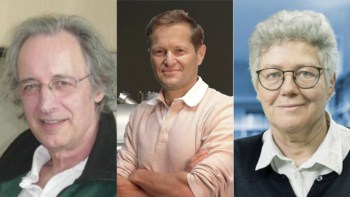
Dual-comb spectroscopy – absorption spectroscopy that utilizes the interference between two frequency combs – has been performed at ultraviolet wavelengths using single photons. The work could lead to the use of the technique at shorter wavelengths, where high-power comb lasers are unavailable. The technique could also find new applications.
Since their invention at the dawn of the 21st century, frequency combs have become important tools in optics. As a result, Theodor Hänsch of the Max Planck Institute for Quantum Optics in Germany and John Hall of the US National Institute for Standards and Technology shared the 2005 Nobel Prize for their invention. A frequency comb comprises short, periodic light pulses containing a very broad spectrum of light with intensity peaks at regular frequency intervals – resembling the teeth of a comb. Such spectra are particularly useful whenever light at a precisely defined frequency is needed, such as in atomic clocks or spectroscopy.
In traditional spectroscopy, a frequency comb can be used as an “optical ruler” when probing a sample with another laser. “You have a continuous-wave [CW] laser interacting with the sample that you want to analyse and you want to measure the absolute frequency of this CW laser,” explains Nathalie Picqué of the Max Planck Institute of Quantum Optics. “And for this you beat the laser with the frequency comb. So the frequency comb gives you the possibility to measure any frequency but at a given time you only measure one.”
Intensity changes
In contrast, dual-comb spectroscopy exposes the sample to broadband light from a frequency comb itself. As the input is broadband, the output is also broadband. However, the light passing through the sample combines with the light from a second frequency comb with a slightly different repetition frequency at an interferometer. The changing intensity of the light emerging from the interferometer is recorded (see figure).
If the sample has not interacted with the first frequency comb – the periodic intensity change simply reflects the difference in the repetition frequency between the combs. However, if the sample absorbs light from the comb, this alters the shape of the intensity modulation. The absorbed frequencies can be recovered from a Fourier transform of this temporal interference pattern.
Dual-comb spectroscopy has been very successful at infrared frequencies. Using the technique at higher frequencies, however, is problematic. “There are no ultrafast lasers that directly emit in the ultraviolet region,” explains Picqué, “so you need to use non-linear frequency conversion, and the more you want to go into the ultraviolet, the more stages of non-linear frequency conversion you need.” Non-linear frequency up-conversion is very inefficient, so the power drops at each stage.
Low-power solution
So far, most researchers have focused on increasing the power in the incoming infrared laser. “You have a very challenging experiment with high power lasers, a lot of noise and a very expensive system,” says Picqué. In the new research, therefore Picqué, Hänsch and colleagues at the Max Planck Institute for Quantum Optics created a system with much lower power requested.
The researchers up-converted two infrared combs twice, first in a lithium niobate crystal and then in bismuth triborate. The resulting ultraviolet combs generated average optical powers of at most 50 pW. The researchers passed one of these through a cell of heated caesium gas, while the other one was sent straight to the interferometer. One arm of the interferometer was sent to a single photon counter. “There are really very few counts,” says Picqué; “If you take one scan the signal does not look like anything.” However, they then repeated exactly the same scan over and over again. “When we repeat the scan 100,000 or close to a million times we get our time domain interference signal, which is the signal we are looking for.”

New technique boosts the performance of dual optical frequency combs
In around 150 s of scanning time, the researchers could resolve two atomic transitions in caesium that have similar frequencies, with signal-to-noise ratios of about 200. They could also observe the splitting of one of the transitions caused by the the hyperfine interaction.
“The idea of working at very low light levels is very counterintuitive,” says Picqué. “We show that the technique can work with optical powers that are one million times weaker than what has been used before.” They now hope to push to even shorter wavelengths in the vacuum ultraviolet. Aside from ultraviolet spectroscopy, the capacity to utilize dual-comb spectroscopy at very low powers could prove useful in a variety of other situations, explains Picqué, such as where samples are prone to radiation damage.
Dual-comb expert Jason Jones of the University of Arizona, who does experiments far into the vacuum ultraviolet is enthusiastic about the Max Planck work. “No matter how far you go into the ultraviolet, you’ll always have some minimum amount of light because of the way it’s generated, so if you can use less light, you’ll always be able to go deeper,” he says. “Being able to use single photons and still get good signal-to-noise spectroscopic results is significant for that.”
The research is described in Nature.



